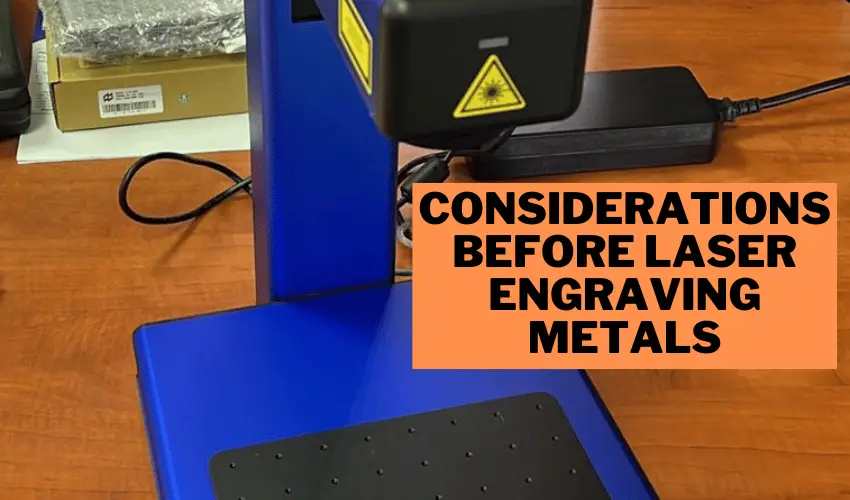Laser engraving metal is a precise and versatile technique used across industries to create detailed designs, logos, and text on metal surfaces. However, before starting a laser engraving project on metal, there are several key factors to consider to ensure optimal results and safety.
These include selecting the right type of laser, understanding the properties of different metals, and taking precautions for heat and reflection management.

In this article, we’ll guide you through the essential considerations you need to keep in mind before laser engraving metals.
Table of Contents
Top 5 Considerations Before Laser Engraving Metal
1. Properties of Metal
Knowing about the properties of the metal you plan to work with is quite essential. It is because each metal has its unique characteristics and reactions to the laser beam.
- Steel – Given its hardness or solidity, steel takes more time to engrave than other metals. It’s easier to make white markings than black ones.
- Aluminum – Engraving aluminum at high speed is feasible as it easily absorbs fiber laser light.
- Stainless Steel – You can only avoid rust if the chromium oxide layer on the metal’s surface is not damaged. When this occurs, ‘annealing’ is the laser process of choice.
- Copper – Marking copper is not as simple as aluminum or stainless steel but still possible with a good quality fiber laser. Copper is highly reflective which means that it only absorbs small amounts of laser light
- Lead – You can mark/engrave lead without much hassle due to its strong absorption of fiber laser light.
- Anodized aluminum – For anodized aluminum, you can either engrave it beforehand or on the anodized layer.

2. Types of Lasers
The two most commonly used types of lasers for metal engraving are CO2 lasers and fiber lasers.
CO2 and Diode lasers are usually employed on non-metal materials such as wood, glass, and plastic. Whereas, Fiber lasers are ideal for engraving a wide range of metals, from steel to copper, as they offer extensive versatility. You can engrave metals with a CO2 Laser by using a marking spray or paste. Anodized Aluminum can be engraved directly with a CO2 Laser.
To permanently engrave a metal, you need a fiber laser with a power of 20W. You can optimize the beam quality from fiber lasers thanks to their versatility.
You can adjust it to be greater than conventional lasers with comparable average output power. The quality of the beam governs the beam’s spot size. This, in turn, determines the width and precision of the laser engraving.

3. Associated Costs
When considering laser engraving metals, cost plays a significant role. The laser engraving machines’ prices can range widely based on factors such as the model chosen, the capabilities it offers, and the accuracy level. Generally, fiber lasers are costlier than CO2 lasers, given their superior efficiency and quicker engraving speeds.
There are other costs to think about post investing in a laser engraving machine. Common expenditures include labor, parts, and consumables, including lenses, reflecting mirrors, and laser tubes. Additionally, the optimal performance of some equipment depends on frequent maintenance, while others can go longer without service & maintenance requirements.
It’s also crucial to factor in operating expenses. The amount of energy required for laser engraving can vary significantly based on the laser’s output power and frequency. The energy costs can increase with both the intensity and frequency of consumption. Consider it as part of the total expense when pricing out laser engraving.
4. Design
Design is a crucial element when laser engraving metals. It dictates the aesthetics of the final product immensely. The laser beam can generate detailed and exact engravings. But it depends on the design getting engraved and the features offered by the laser engraving equipment. On the other hand, due to the versatility and precision of Desktop CNC Mills, they also offer engraving capabilities.
It is crucial to consider the laser engraving machine’s resolution potential while sketching an engraving’s design. As if they feature the potential of producing superior resolution, then they are capable of producing much more complicated patterns. Knowing the laser engraving machine’s resolution allows for a more precise design.
The contrast between the design and the metal is another aspect to think about. During laser engraving, the metal surface is heated until it vaporizes. It allows the laser beam to etch the desired pattern into the metal. For the pattern to be noticed, it must be well differentiated from the metal background.
Last but not least, think about how big the design will be in comparison to the metal surface. The design dimensions greatly influence the amount of laser power needed to make the engraving and the clarity & intricacy of the pattern.
5. Safety Considerations
Safety must always be a top priority when laser engraving metals. The laser engraving process requires several precautions to safeguard everyone involved and nearby. The usage of personal protective equipment (PPE) is crucial in ensuring worker safety. They could include stuff like safety glasses, gloves, and protective gear.
Ventilation is another factor that you must account for safety. During the process, laser engraving equipment can release toxic fumes. These contaminants can be harmful to the lungs of anyone near them. The work area should have enough ventilation. Equip the area with tools such as an exhaust system, dust extraction unit, and a fume extractor.
Furthermore, it is crucial to provide personnel with requisite training on the machine’s operation. Aside from that, they need training on how to respond in the event of an emergency, such as an injury.
Conclusion
Laser engraving is an effective, adaptive, and precise technique for crafting detailed engravings and designs into metals. So consider and put in place the factors discussed in your laser engraving process. It can help you streamline the metal engraving process at your facility. That, too, without compromising the production quality.
Also Read: Laser Engraving Machine For Metal – Which One Is Best?
